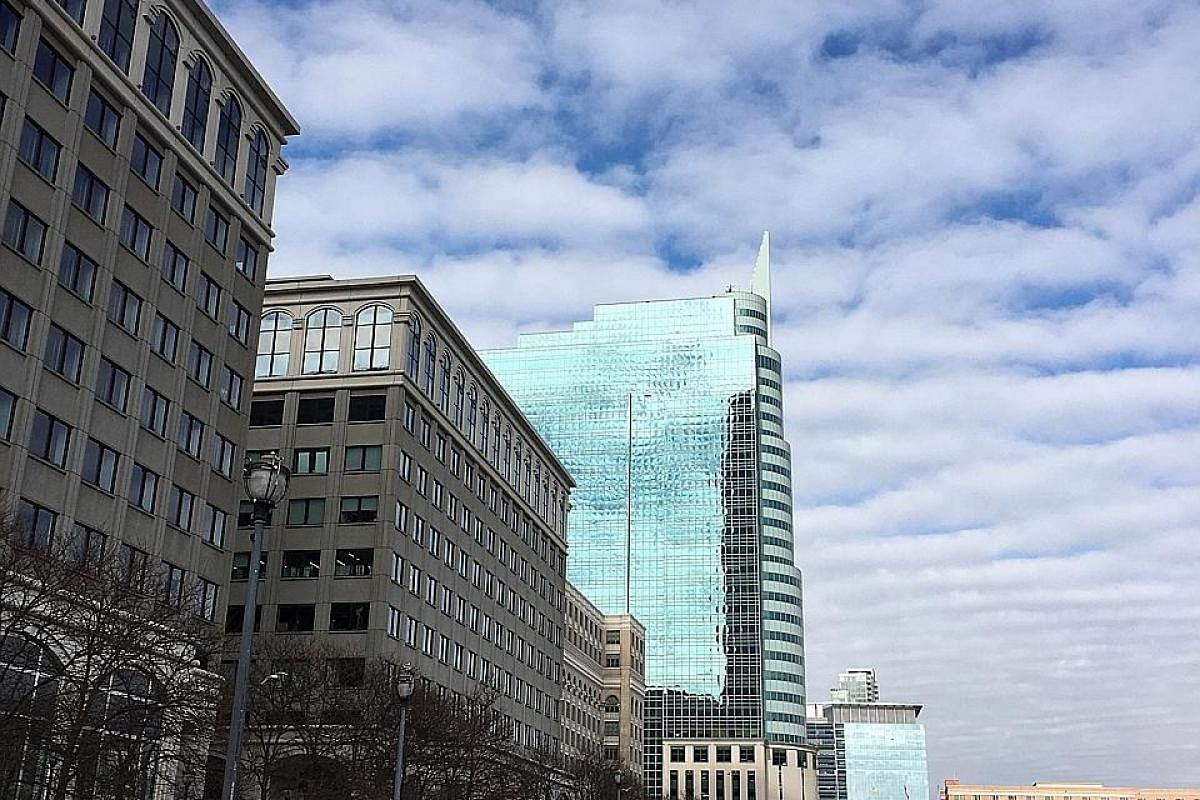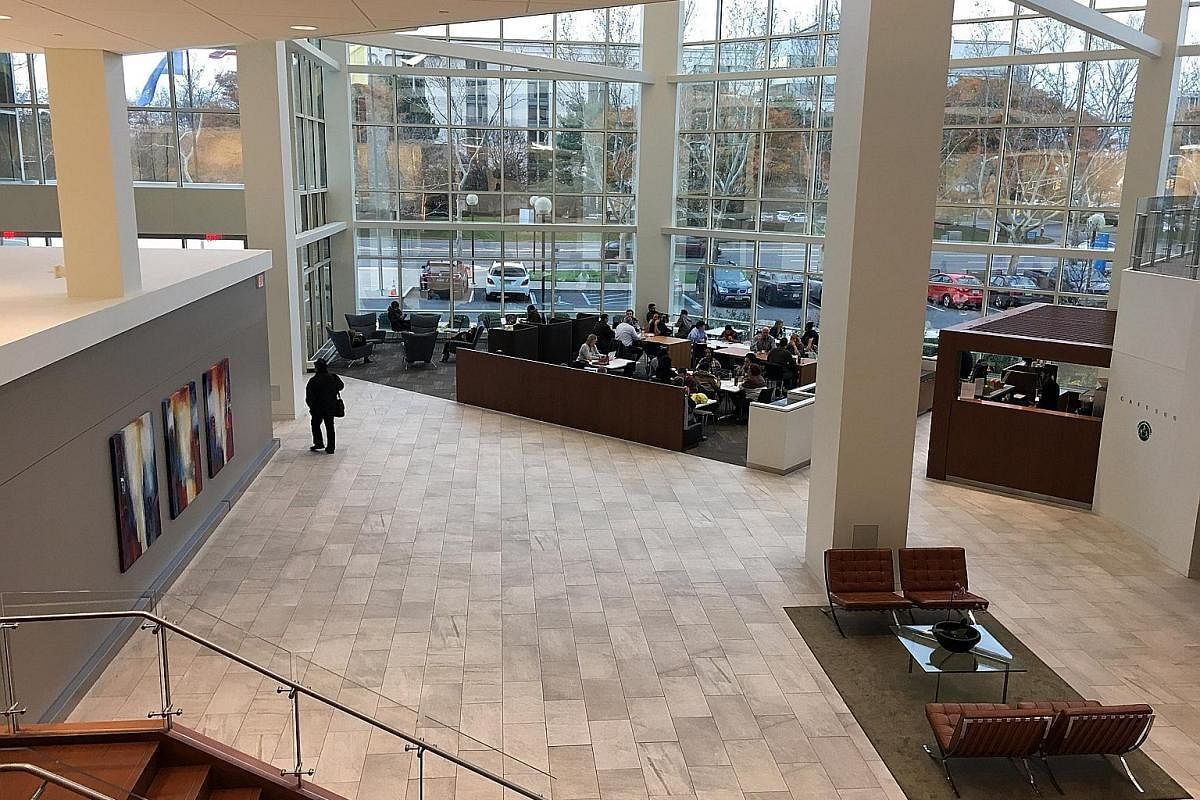On the (other) waterfront
Jersey City's 'residential boom' holds promise for Manulife US Reit


Sitting across the water from New York City's pulsing financial centre, Jersey City's waterfront district has been known for years as Wall Street West - the quieter sister to Midtown Manhattan with far more affordable rents for back offices and the like.
Today, landlords along Jersey City's Hudson Waterfront are rising with the tide, brokers say. Hudson Waterfront refers to the part of Jersey City that can be seen if you look across the Hudson River from Manhattan.
"Jersey City is casting off its stigma as a cheap back-office location and undergoing the biggest residential boom in its history. It's starting to get this cool factor," Mr Robert Lowe, vice-chairman of brokerage at Cushman & Wakefield (C&W) told the media and analysts during a recent visit organised by Manulife US Reit.
On Nov 1 last year, Manulife US Reit completed the acquisition of 10 Exchange Place in Hudson Waterfront for US$315.1 million (S$419 million).
The 30-storey Class A office tower with a shimmery green facade and tall spire is just 10 minutes or one stop away from Manhattan's World Trade Centre train station.
Many factors make the neighbourhood a sensible alternative to Manhattan, not least the Grow New Jersey corporate incentive programme, which expires next year.
But to explain why office rents in Hudson Waterfront are skipping ahead of the rest of New Jersey, the arrival of the millennial generation (born between 1980 and 2000) cannot be ignored.
In recent years, Hudson Waterfront has seen an influx of young professionals keen to rent apartments in an up-and-coming part of town not far from Manhattan.
Although gentrified Brooklyn is the borough that gets the most attention right now, "Jersey City has a 10-year head start on Brooklyn in terms of local residential and local amenities", noted C&W principal economist Ken McCarthy.
In fact, more millennials live in Hudson County on a percentage basis than in New York City.
Where the millennials go, so follow the employers that want to hire them.
"If you want to hire that generation, you have to be where they are," said Mr McCarthy.
"If you're trying to attract millennials, they don't want to work in their father's skyscraper."
Over the last year, designer label Tory Burch moved part of its corporate offices out of Manhattan and across the Hudson River into the same building that now houses Forbes Media. L'Oreal and Jet.com also signed leases to take up more space in Hudson Waterfront.
As more tech and creative-type companies move in, Hudson Waterfront's tenant mix has diversified in tandem with economic growth in the United States and become less reliant on the financial services industry.
Within Manulife US Reit's office tower, Amazon is the largest tenant, accounting for 4.5 per cent of the Reit's cash rental income.
Other top tenants include ACE American Insurance Company, Kuehne & Nagel, Opera Solutions, EXL Service and Genpact. Nuts retailer Nuts.com moved in to occupy the entire top floor of the Exchange in September.
10 Exchange Place is 97 per cent leased with an average in-place rent of US$38.18 per sq ft (psf) per year as of Sept 30 last year. In the US, rents are quoted on a psf per year basis.
This poses an opportunity for rental reversion in future leases, given higher rates being charged elsewhere, the Reit manager said.
In the third quarter last year, Hudson Warefront's office market had an average asking rent of US$44.44 psf per year, up from US$39.43 in the same period a year earlier, C&W data showed.
That vacancy rates have climbed to 14.4 per cent from 12.5 per cent in the same period and will likely rise further is not concerning, said C&W.
Mack-Cali Realty Corp, the largest office landlord in Hudson Waterfront, is bullish on the market and hiked asking rents after renovating some assets.
C&W expects asking rents to stay constant over the next 12 months, as rising rents in Manhattan continue to price tenants out of Class A office space. Average asking rents in Manhattan can be around US$73 psf per year.
And whereas plenty of construction is under way in Brooklyn, no new office projects are scheduled for delivery in Hudson Waterfront within the next five years, C&W said.
Instead, the building under way two streets down from the Exchange at 99, Hudson Street, in Hudson Waterfront is a US$500 million work in progress owned by China Overseas America. The mixed-use condominium tower will be New Jersey's tallest, housing 781 apartments when construction is completed next year.
Outside of the Hudson Waterfront and a half-hour's drive north from Manhattan is Secaucus, New Jersey, where another of the Reit's latest acquisitions is located.
Manulife US Reit acquired 500 Plaza Drive, an 11-storey Class A office building with high ceilings and walkable amenities for US$115 million on July 20 last year.
If you squint past the suburbs, a small Manhattan skyline is visible from Secaucus. The Plaza is Manulife US Reit's maiden acquisition since its initial public offering in May 2016.
Unlike Hudson Waterfront where rents are rising, in the Meadowlands sub-market where the Plaza is located, rents for Class A space have been stagnant, based on JLL data.
Even so, brokers have witnessed a flight to quality and the Plaza, which underwent a US$16 million refurbishment in 2015 and 2016, is 98.9 per cent leased with a long weighted average lease expiry (Wale) of 8.6 years.
Apparel retailer The Children's Place calls the Plaza its global headquarters and accounts for 5.5 per cent of the Reit's cash rental income.
Other tenants include Quest Diagnostics, AXA Equitable Life Insurance, Xerox Business Services, Verizon and MCM Products.
Average gross rent at the Plaza was US$29.94 psf per year as at Sept 30, 2017. Average asking Class A rent for direct space in the Meadowlands remained at US$26.60 psf per year in the third quarter.
The vacancy rate for Class A office space was 20.8 per cent in the third quarter last year as firms throughout the country downsized but Mr Steve Jenco, JLL's vice-president of suburban tri-state research, sees vacancies falling over time as more supply gets taken off the market.
"We start to see it now and we're going to see it in 2018 and 2019. Our inventory is dropping due to buildings being repurposed, whether they go retail or residential," he said.
Class B offices are being refitted as medical suites and outpatient surgery centres while some of the obsolete class C space is being knocked down and converted for industrial use, which has become more valuable in the light of the e-commerce boom, said Mr Jenco.
"If you are a large tenant and you are looking for a Class A space, there's not a lot of options for you."
Manulife US Reit trades at a forecast distribution yield of just under 7 per cent for 2018.
All five of the Reit's Class A office properties are freehold, with strong cash-flow visibility (Wale of of 5.9 years) and a committed occupancy of 95.7 per cent as at Sept 30.
Ms Jill Smith, chief executive of the manager of Manulife US Reit, said: "Located just minutes from New York City, both our acquisitions in New Jersey provide unique growth opportunities as it captures the influx of millennials...
"We believe this trend of staying near their offices with surrounding amenities will continue to drive rents in key markets across the US and bodes well as Manulife US Reit seeks future yield-accretive deals in the world's largest real estate market."
Join ST's Telegram channel and get the latest breaking news delivered to you.
A version of this article appeared in the print edition of The Straits Times on January 03, 2018, with the headline On the (other) waterfront. Subscribe
